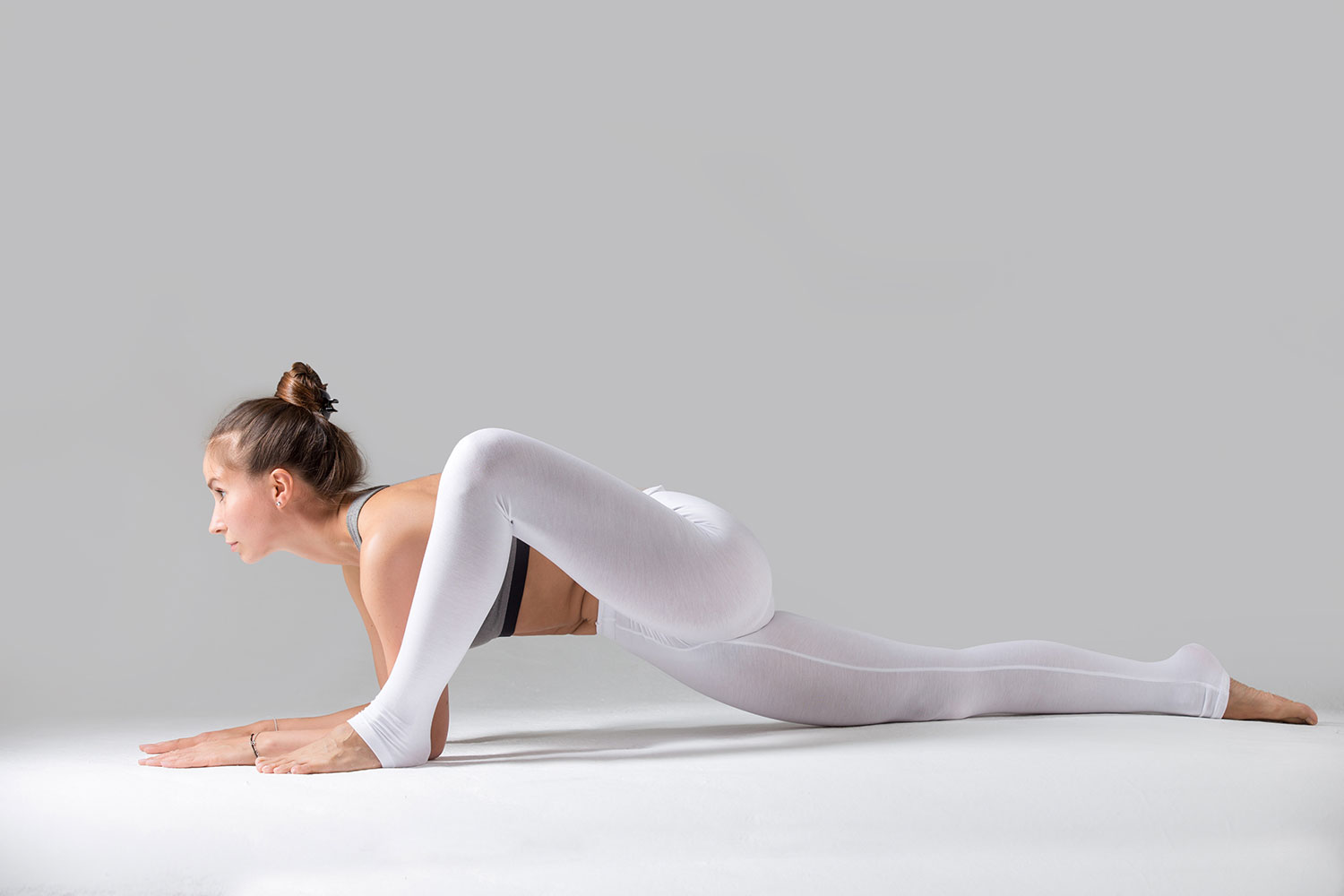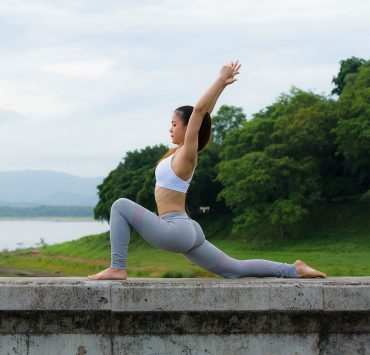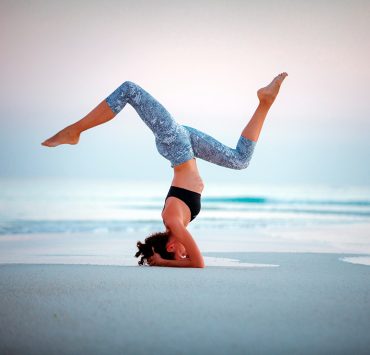
Having been a teacher’s assistant at over 50 yoga teacher…
Our hips are what make us uniquely mobile bipeds. The structure of our pelvis is vital to our body’s functionality. Unfortunately, due to our increasingly sedentary lifestyle, our hips are getting tighter and tighter. Whether it is in the car, in a chair, or on the couch, every time we sit, our hips become weaker and more limited. In addition, hips can also become tight if we overwork these muscles in the gym. So, how do we fix this? Staying active is key to pelvic health, and yoga can help loosen taut muscles and overworked ligaments through stretching and strengthening. Here are 10 hip opening postures for beginners that you should do right now!
Structure of The Hips and Pelvis

When our hips are tight, we may feel this in different areas of the body. The hips flexors are the “front hips”, stemming from the lower abdomen down the front of the quadriceps. The piriformis is on each side of the gluteus medius, or the outside hips. The groin accounts for inner hip mobility, located deep within the pelvis and into the upper hamstrings.
The hip joint is comprised of 5 layers. Starting with the deepest part is the joint itself, a boney, ball shaped head that fits into the the hip socket. The joint is encased in connective tissue, which is underneath the joint capsule. This is held by ligaments and fluid filled sacs. The ligaments of any bodily structure connect bone to bone. Lastly, the most superficial layer is comprised of muscles and tendons.
The deeper layers attribute to stability of the pelvis. The ligaments determine the range of motion of the joint itself. Shorter ligaments can account for inflexibility, while longer ligaments lead to hypermobility. The muscles and tendons on top of everything else create motions of the hip. All of these layers must work together in order for the hips to be healthy and active.
If you have pain or previous injuries in your hips, talk with your medical provider before starting any of these exercises. In general, any hip injury is contraindicated with these poses.
If you are new to hip openers or your hips feel unstable to begin with, move slowly and subtly.
Ardha Kapotasana — Half Pigeon Pose

This posture stretches the hip flexors and piriformis.
Begin in a table position on your mat.
Bring your right knee into the chest and rotate the leg so that your right foot is in front of your left knee. Place the leg and foot down. Your right knee should be externally rotated, and the outside of the left foot is on the ground.
Stretch the left leg behind you and straighten it as much as possible.
If your right hip is severely elevated off the mat, place a blanket or pillow underneath it to square and stabilize the hips. Sink into this hip to deepen the stretch.
Place your hands by your hips and lift your chest as you deeply inhale and exhale.
Hold this posture for 1 minute. With every exhale, release tension.
To release, place your left toes on the mat behind you and lift both legs off the floor. Stretch into a downward dog for 5 breaths.
Come back to table position, and repeat with the left leg.
Anjaneyasana — Crescent Lunge Pose

Crescent Lunge opens the hip flexors while in a slight back extension.
Begin in Adho Mukha Svanasana, downward facing dog pose.
Raise your right leg high to the sky, then sweep the knee into your chest.
Place your foot in between your hands in a runner’s lunge. Make sure your hips are square and the ball of your left foot is firmly in the mat behind you.
Lift your upper body up towards the ceiling, keeping your legs in the same posture. Tuck your pelvic floor down and bring the belly button in towards the spine.
Lift the arms up towards the sky, and bring your gaze up to the hands. Hold crescent lunge for five breaths.
To release, return to runner’s lunge. Sweep the right leg back to a high plank position, and shift your hips up to downward dog again.
Repeat on the other side.
Baddha Konasana — Bound Angle Pose

Bound Angle Pose opens the groin in a gentle spine flexion.
Straighten your legs in front of you on your mat. If your hips and groin are especially tight, stack your hips on top of a folded blanket.
Bend your knees and bring the soles of your feet together. Pull them as close to your pelvis as possible, and open the knees out to the sides.
With one hand stacked on top of the other, grasp the outer part of the feet that are pressed against the mat.
With the arms now extended, lift the crown up to the sky and relax the shoulders.
Stay in this posture for at least 1 minute, and up to 5 minutes for deep hip opening.
For an even deeper stretch, fold the upper body over the legs and bring your forehead towards the mat.
To release, lift your body up, release grip of the feet, and bring the knees together.
Place your hands on the floor, and rock the knees from one side to the other.
Supta Virasana — Reclined Hero Pose

This posture is deep hip flexor stretch and back bend. Avoid if you have low back pain.
Kneel on your mat, touching your knees together in Virasana, hero pose.
Slide your feet apart slightly wider than your hips, so that your buttocks is on the ground with the tops of the feet on the floor on both sides of the hips. If you cannot sit down comfortably, stack a pillow or blanket underneath the sitz bones.
Begin to lower your back to the floor behind you. If you feel uncomfortable, place a bolster on the mat to support you.
Lean into your hands, forearms, and elbows as you recline.
Once you are on your elbows, release your body down to the floor or on top of your bolster.
Lay your arms on the floor by the sides and stay in Supta Virasana for 1 to 5 minutes maximum.
To come back up, press the arms against the mat. Use your hands and forearms to lift your torso off the ground, bringing your head up last. Release both legs in front of you and take forward fold for a counter stretch.
Utthan Pristhasana — Lizard Lunge Pose

Lizard Lunge targets the outside of the hips, especially the piriformis.
Begin in downward facing dog on your mat.
Bring your right knee into the chest, then step the foot to the right of both hands.
Lower your left knee to the earth and rest the top of your left foot to the mat. Lower your forearms on the mat in front of you if you can. If this isn’t possible, that is okay!
Your right foot should be planted to start. Throughout posture, you can slowly open the knee out to the side for a deeper stretch by balancing on just the outside of the right foot.
Focus on exhaling and softening any tension in the hips and hip flexors.
Hold posture for 1 minute on the right side.
To release, return to a runner’s lunge and sweep the right leg back into downward facing dog.
Repeat on the left side.
Agnistambhasana — Fire Log Pose

Fire log pose is another great piriformis stretch.
Begin in a seated position on your mat.
Place your right leg parallel on the mat and stack your left leg on top of the right in an equally parallel position. Your legs will look like fire logs, stacked neatly one on top of the other.
You may already feel a stretch here. If so, stay here. If you yearn for a deeper stretch, begin bending forward from the waist until your feel a stretch.
Hold this posture for 1 minute, focusing on releasing tension as you exhale.
To release, lift yourself back up and unstack your legs.
Repeat on the other side by stacking the right leg on top of the left.
Ananda Balasana — Happy Baby Pose

Happy Baby is a gentle posture that encourages hip opening and relaxation.
Lie on your back on your mat with your legs extended in front of you.
Bend your knees into your chest and hold the outsides of your feet or big toes with your hands.
Open your knees wider than your hips and lift them in towards your armpits.
Gently push your feet into your hands to create resistance. You can hang out here for 1 minute, or straighten one leg at a time and rock from side to side.
To release, let go of the feet and return them to your mat.
Malasana — Garland Pose

This squatting posture opens the hip joints and stretches the groin.
Begin in a standing position on your mat. Open your feet shoulder distance apart and point the toes out at a 45 degree angle. Your heels will be facing each other.
Bend your knees out to the sides and lower your hips into a squatting position. You can place the hands on the floor for balance.
If your heels come off the ground, place a blanket underneath them for support.
Separate the thighs and press your elbows into your inner thighs.
Bring your hands together in a prayer mudra and lean the upper body slightly forward.
Hold posture for 1 minute.
To release, place your hands on the floor and lower your hips back to the earth. Return to a seated position on your mat.
Upavistha Konasana — Wide Leg Forward Bend Pose

Wide leg forward bend increases joint mobility and opens the groin.
Take a seat on your mat in staff pose, Dandasana, with your legs extended in front of you. If your groin feels tight, place a folded blanket underneath your sitz bones.
Lean back slightly, place your hands on the floor by the sides, and open your legs as wide as you can.
Rotate the thighs internally by reaching underneath the bottom of each thigh and pulling it away from you. Your knees will point up towards the ceiling.
Flex both feet so the toes point up to the sky.
Walk your hands between the legs and continue to extend the torso forward with a straight back. Once you have gone as far as you can, you may round the back and lower your forehead towards the mat.
Stay in this posture for at least 1 minute.
To release, walk the hands back in towards the groin and lift up one vertebrae at a time, head coming up last.
Virabhadrasana II — Warrior II Pose

Warrior II opens the hip flexors and groin, while strengthening and stretching the glutes and quads.
Begin in Tadasana, mountain pose, standing on your mat.
Step your right leg back behind you and rotate your heel to the floor, turning your right foot out 90 degrees.
Bend your left knee over the ankle, and make sure that it is not rotated inward. Press firmly into the bottom outside of your left foot to bring the knee out towards your left hip.
Tuck your pelvis and open the groin by pulling the belly button in towards the spine. The back leg should remain straight.
Open the arms out to airplane wings and gaze towards the left fingertips.
Hold posture for 10 breaths. To release, straighten the front leg and step the right foot back to meet the left.
Repeat on the other side.
Your Hips Deserve Some TLC!

Whether you are sedentary most of the day, or you are an extremely active athlete, your hips can become tight no matter what. Any stretching regimen is key to pelvic health, and these 10 yoga postures can help get you started. Make sure that you go slow and are aware of your breath and movements at all times. Even stretching too forcefully can cause injury, so take your time and pace yourself.
In yoga, we not only release physical tension through the body, but emotional tension as well. Opening the hips can be profounding healing and can help you let go of fears, sadness, and painful memories. If you feel emotional during or after these postures, let these feelings come up and through. Honor your experience, and thank your hips for helping you.
Above all, yoga is about loving yourself.
What's Your Reaction?
Having been a teacher’s assistant at over 50 yoga teacher trainings worldwide, Rebecca Rebecca has a firm grasp on the fine art of yoga and meditation. In her work, she carefully reflects on a vast expanse of knowledge to help others find peace in both body and mind.














